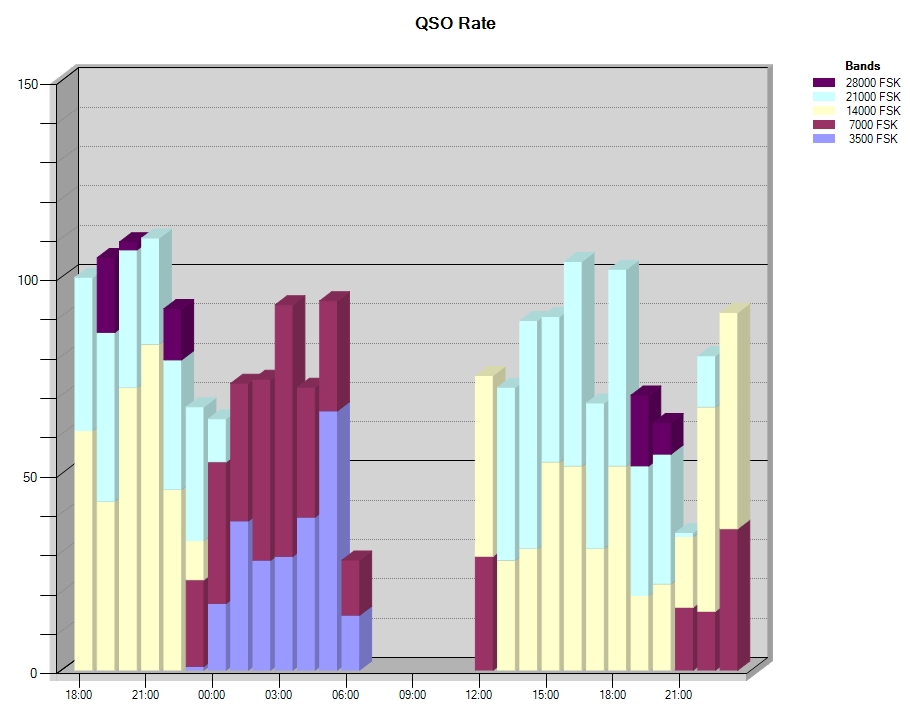AA5AU Contest Notes – 2013 ARRL RTTY Roundup
Twenty-five years of the ARRL RTTY Roundup… I was only 30 years old when I operated in the first ever Roundup in 1987. I can’t say it seems like yesterday, because it doesn’t. It seems like a long time ago. I don’t remember the actual contest or even where I was living at the time or what kind of radio or antenna I was using, but I do remember that it was a lot of fun. So here we are 25 years later.
Pre-Contest
Preparation for this contest started in early September 2012 when I returned home from evacuation of Hurricane Isaac to find my 2-year old 3-element SteppIR badly damaged, my 55′ tower slightly bent and my KT34, on a second tower, no longer operable on 20 meters. I had a lot of work ahead of me in order to get the station prepared for this year’s Roundup. The rebuild of the antenna system is well-documented here for those interested. My passion for operating in the ARRL RTTY Roundup is the driving force that keeps me rebuilding after all these storms. If it wasn’t for the Roundup, I probably would have given up after the first one.
I ended up lowering my 55′ tower to 45′ with a brand new 3-element SteppIR on top. I took parts from the damaged 3-element SteppIR and built a modified 2-element SteppIR which replaced the KT-34 on the 35′ tower. The 30/40 meter loop dipole was badly damaged in the storm and I had received the parts to fix it. I actually did repair it and had intentions of installing it on the 2-element SteppIR but I didn’t get done in time for the contest. Not getting this done would have a big impact on me but I didn’t know it at the time. I re-installed my 80 meter inverted vee off the 45′ tower and installed a 40 meter inverted vee off the same tower, both using DXEngineering baluns. The two baluns were inches apart. In pre-contest practice sessions, it was obvious the two inverted vee antennas were too close to each other. The interference on 40M when transmitting on 80M was bad. I worked diligently to try to correct it. I really didn’t have anywhere else to put the 40m inverted vee so I built a stub to null 80 meters but that didn’t work. I tried some other things that didn’t work either. The best thing I could come up with was to use my Pixel receiving loop on 40 meters when transmitting on 80. This minimized the interference but did not eliminate it. I finally realized I was not going to fix this problem before the contest.
The propagation forecast for the contest was not great. We expected the flux to be in the low 100 range, so when the flux rose to 143 before the start, there was hope that ten meters would give us extra contacts like it did last year. But something told me this wasn’t going to happen and I ended up being right. I’m not sure how I knew this, but my hunch was correct. One thing I changed for this year was to get rid of the third radio. I wouldn’t do SO3R this time because I’m not set up for it with these antennas. A check of the weather showed no threat of thunderstorms during the weekend. No memories of my 2009 weather-related blunder to contemplate.
Flunking Psychology 101
Because of all the unknowns with my new antenna setup, I set a goal of 2000 contacts, which was a mistake. I made 2200 contacts in 2012, so lowering my expectations for this year was an act of total stupidity on my part. I told myself I was trying to be realistic, when it fact, the problem between 40 and 80 meters psyched me out. I was mad at myself for not getting 40M added to the 2-element SteppIR and I allowed it to have a negative impact before the contest even started. The 200 contacts I would miss on 40 meters this year, all on Saturday night, would have put me at my 2012 total. In hindsight, I tried too hard to make 40 meters work Saturday night. In years past I had huge runs on 40 meters. I made the critical mistake of trying to run on 40 meters Saturday night even though it wasn’t working. I was lazy or stubborn or stupid or all three. When I realized what I had done, it was too late. All I could do was tell myself that tomorrow would be better. I would quit earlier Saturday than I normally do and kick ass on the high bands starting early in the morning to make up for the lost contacts. I still had the second half of the contest to go and I wasn’t about to let a mistake, no matter how big it was, impact the fun of big high band runs on Sunday. That’s basically how it went.
First 12 Hours
I had decided beforehand that I would start the contest on 15 and 20 meters, and check 10 meters later. I had a feeling that 20 was going to be the best band so I started the contest with the big antenna on 20 and the smaller antenna on 15. It was obvious from the start that the 3-element SteppIR at 45′ is much better than the 2-element SteppIR at 35′. Duh! However, the little SteppIR worked just as good as the KT-34 it had replaced and would prove it’s worthiness as an effective antenna. It was good enough for a second radio, but my plans to revert it back to 3-elements with the 30/40 loop dipole have been expedited. I’m looking forward to having two 3-element SteppIR yagi antennas in the very near future.
I had big runs on 20 meters and smaller runs on 15 throughout the day Saturday and I was pretty satisfied with the way things were going. The start was pretty typical of most of my later Roundups where the rate is usually way above 100/hr for the first few hours, then falls off a bit but keeping the average above that 100/hr overall rate. My rates for hours 1 through 5 were 100, 106, 110, 110 and 94. I did check ten meters twice during the daylight hours to find everything was to the west coast. I did a couple of quick S&P passes there, but did not try running on ten at all the whole weekend. Ten just sucked all weekend as I knew it would.
Normally when the rate starts falling on 15 in the late afternoon, it’s time to move to 40 meters. With the rate falling quickly after sunset at 2300Z, I went to 40 meters at 2320Z. There were a lot of stations on 40, but it didn’t seem as crowded, as shown on the PRO III scope, as it normally is. This is where my struggles began. The interference on 20 meters was significant when transmitting on 40, so I tried something that actually worked well for me. I put the big SteppIR on 15 instead of 20, and there was no interference on 15 when transmitting on 40. But 15 was going away quickly after sunset, so I decided to move that radio to 80 meters at 2340Z. I only worked one station on 80 and decided it was too early for 80, so went back to 15. Finally I moved back to 80 at 0019Z for good. The interference on 40 when transmitting on 80 was terrible. And I just couldn’t make 40 work for me. This took a major toll on my score as the rate between 2300-2400Z was only 67 and between 0001-0100Z, it tumbled to 64. Usually, the move to 40 and 80 allows for my rate to jump back over 100/hr for a few hours and my “norm” is to average 100/hr for the first 12 or 13 hours. That didn’t happen. Forty meters just seemed strange and I started to panic a little. I had the interference, but it wasn’t enough to completely shut 40 down for me. I could still copy stations, but the band seemed strange like it was too long. I’ve had that happen in the past, but I had already convinced myself that the problem was my 40M inverted vee and the 80 interference. Maybe it wasn’t, I don’t know. In the next 5 hours, the rates were 74, 74, 94, 73, and 94. So after twelve hours (at 0600Z) I had only 1060 contacts. That’s 140 contacts below my normal average. Since in years past I would go to at least 0700Z and sometimes 0730Z (if 20 was open to EU at their sunrise), with continued high rates, I knew I was drowning. After only 29 contacts between 0600-0630Z, I shut it down. I was nearly 200 contacts off pace. I was not happy. I didn’t go to bed right away. I spent a few minutes trying to convince myself I would make this up the next day. I was very tired. Fighting the low bands had really taken a lot out of me. I went to bed and fell asleep quickly but I was so tired I was afraid of not waking up in time, so I set two alarms.
Sunday 1200-2130Z
Last year I took a 5.5 hour rest period, then worked all the way to 2329Z and took the last 30 minutes of the contest off. Post analysis of that recording-setting effort showed that my rate steadily increased in the last couple of hours Sunday. And in years past the last 30 minutes of the contest usually yields the highest rate of the second half of the contest. So this year, I decided to take 5.5 hours again but to save 30 minutes for when the rate is usually slowest on Sunday, which can be anywhere between 1900-2200Z. I would watch the rate meter and make the decision on the fly. With 5.5 hours of rest, I needed to restart at 1200Z on Sunday. This is an hour before my sunrise.
I restarted by running way down around 7036 kHz on 40 meters while S&P on 20 to Europe. At 1200Z, 20 meters was open well into Europe. There was minimal interference on 20 while transmitting at 7036 kHz because the 1st harmonic was at 14072 kHz and most of the stations were high in the band on 20. This helped and I got a good start with 76 contacts that first hour. Occasionally I would check 15, but it didn’t open until an hour later. At 1300Z, it opened fast and was instantly full of signals. The rate fell slightly to 73 between 1300-1400Z, but that was OK. As 15 opened up all the way by 1400Z, the rate started climbing and was 90, 90, then 107 because 20 meters was unbelievably open to everywhere in the USA/Canada and to Europe. I ran 20 meters for two and a half hours on one frequency Sunday morning after 15 opened. What’s most impressive about this great run is that I had put the big SteppIR on 15 to Europe and was running 20 on the smaller antenna. It was working very well for me. I kept checking ten meters but there were very little signals and nothing from Europe at all there. So I continued with 15 and 20 because it was working and I was having a lot of fun. The 40-meter debacle the night before was out of mind.
But something happened between 1700-1800Z when the rate fell to 68. I was running on both radios as I had been for hours but it just slowed down. I checked ten meters and there was little there, so I kept trying to run on 20 and 15 but it was just slow. Analysis of the log shows that I should have gone S&P on 20 meters when things slowed down. This was a mistake that I normally don’t make. In that hour, I had 37 contacts on 15 and only 31 on 20. I was getting tired and had gotten lazy. I had forgotten to post a sign in front of me that says “Go Get That Next Contact”. What a blunder! Finally after 1800Z I went S&P on 20 while running on 15 and the rate climbed back up to 103 between 1800-1900Z. That was a shot in the arm I needed.
After 1900Z, the 20-meter rate fell sharply but this is not unexpected. So I moved from 20M to 10M for twenty minutes S&P to work all the very strong west coast stations. The west coast ops had this great opening on ten but no one else was there. I went back to 20. The rate between 1900-2000Z was 70 and fell to 63 between 2000-2100Z. All the while I was dragging and felt very tired. I had come to a point where I needed rest. I knew it and now was as good a time for it as any. So at 2100Z I shut down for a 30-minute power nap. I climbed into bed, after setting 2 alarms, and fell asleep. Man, I was tired.
Last Two and a Half Hours
I was hoping my power nap would invigorate me and it did. I got up in time to restart at 2130Z. I quickly checked ten meters but it was history – no signals. The PRO III was on 15 meters and I could tell there weren’t as many signals there as before by looking at the band scope, so I restarted on 20 and 40. I did a 25-minute S&P on 40 while running 20, then put the 40 radio back to 15 for S&P there. The rate was 36 for that first 30 minutes and that wasn’t bad. I was feeling better physically and when I went back to 40 at 2230Z, it was rocking. So I went S&P on 40 while running 20 and this worked very well as 20 started getting real good again and just about every station I came across on 40 was new because I hadn’t worked them the night before! The rate between 2200-2300Z climbed to 81. In the final hour I made 94 contacts between 20 and 40 meters. This was very good indeed. I had made my goal of 2000 contacts, barely. But I was drained. I couldn’t remember being that tired at the end of a Roundup. I was exhausted.
Post-Contest Analysis
I encountered several problems in this contest that were all self-inflicted. Whether or not they are fatal is yet to be known. First of all, I should have made the effort to get the 30/40 meter loop dipole installed on the 2-element SteppIR before the contest. Although I have no idea how that would have worked at only 35 feet, I feel it may have reduced the interference from 80 meters since there would have been much more separation between the 40 and 80 meter antennas. Given what I had on 40 meters, a low inverted vee, I should have tried more S&P on 40 meters Saturday night instead of trying to run. I think two of the reasons I was trying to run on 40 was A) I always run 40 at night in the Roundup, and B) I found a couple of “sweet” spots on the band where the 80 interference wasn’t so bad so I stayed there; afraid to move. Kind of like a deer in headlights. I shouldn’t have psyched myself out.
On Sunday, as tired as I was, I probably should have taken that last 30 minutes of rest earlier, say at around 2000Z or 2030Z when the rate started dropping off and I was feeling tired. It’s hard to say, but it’s something to think about for next year. I know one thing, the last two hours of the Roundup are high-rate for me and I need to be there. Despite having my best-ever score in 2012, I should never take 2330-2400Z off like I did then. So at least I didn’t make that mistake again.
I have to guess that having to do another total-rebuild on the antennas may have affected me this year. Getting older doesn’t help, but since I have to do all this antenna and tower work by myself, maybe it took something out me. Don’t get me wrong; I love working on antennas and towers and building stuff. But when you have to totally redo everything 3 times in seven years, it’s enough already. I’m not making excuses. I screwed up and I know it. I told myself I wasn’t going to make 2200 contacts like I did last year and sure enough I didn’t. It doesn’t take a psychology class to figure that one out. Hopefully I won’t do it again. On the other hand, 2000 contacts isn’t bad for low power. It’s the 2nd most I’d ever worked. And depending on log-checking, should be my second best score ever. Despite beating up on myself the whole time, I actually did have a lot of fun.
Twenty-five years from now I will be 80 years old. Wouldn’t it be really neat to operate in 50 Roundups? I guess I have a new goal now. It’s funny how the Roundup can be so inspirational. I’m looking forward to the next 25 years. Oh, and one goal for next year already – 2400 contacts. That 100/hr for 24 hours low power. No one has ever done it. I’m planning on it. Thanks to everyone who worked me.
73, Don AA5AU
Complete SH5 Log Analysis Report for this contest.
Complete CBS Log Analysis Report for this contest.
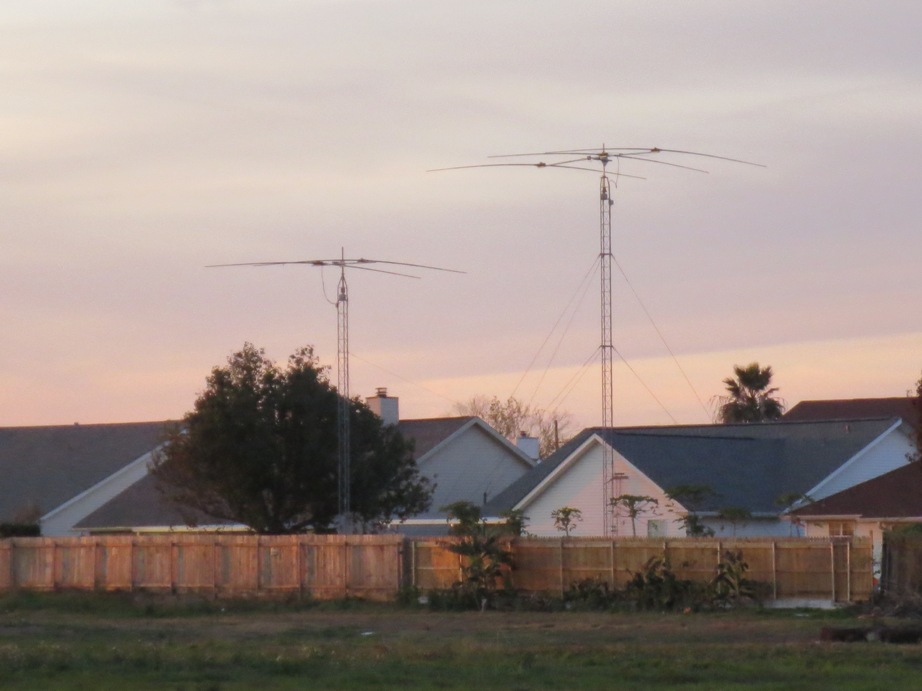 Amateur Radio Station AA5AU antennas for the 2013 ARRL RTTY Roundup (January 2013)
Amateur Radio Station AA5AU antennas for the 2013 ARRL RTTY Roundup (January 2013)
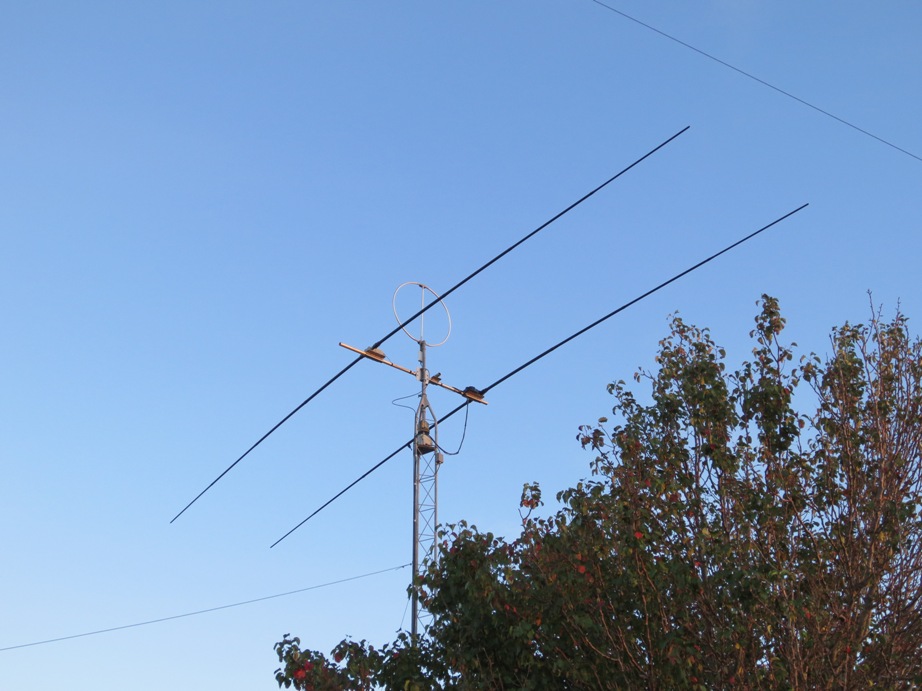 Modified 2-element SteppIR yagi @ 35′ with Pixel receiving loop antenna on top
Modified 2-element SteppIR yagi @ 35′ with Pixel receiving loop antenna on top
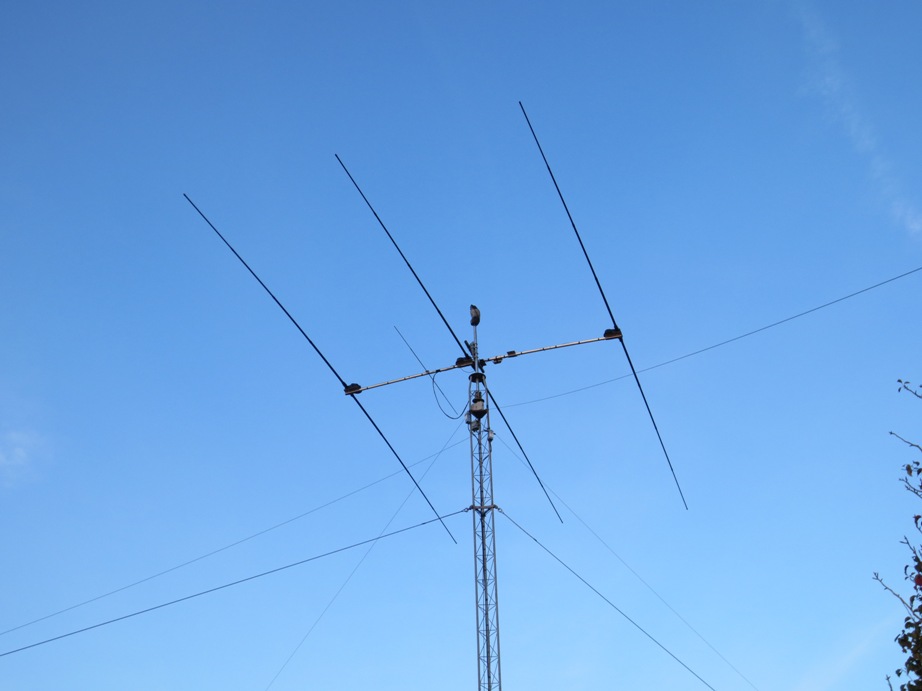 Brand new 3-element SteppIR yagi @ 45′ with 40 and 80 meter inverted vee antennas off the tower at 40′ and plastic owl on top
Brand new 3-element SteppIR yagi @ 45′ with 40 and 80 meter inverted vee antennas off the tower at 40′ and plastic owl on top
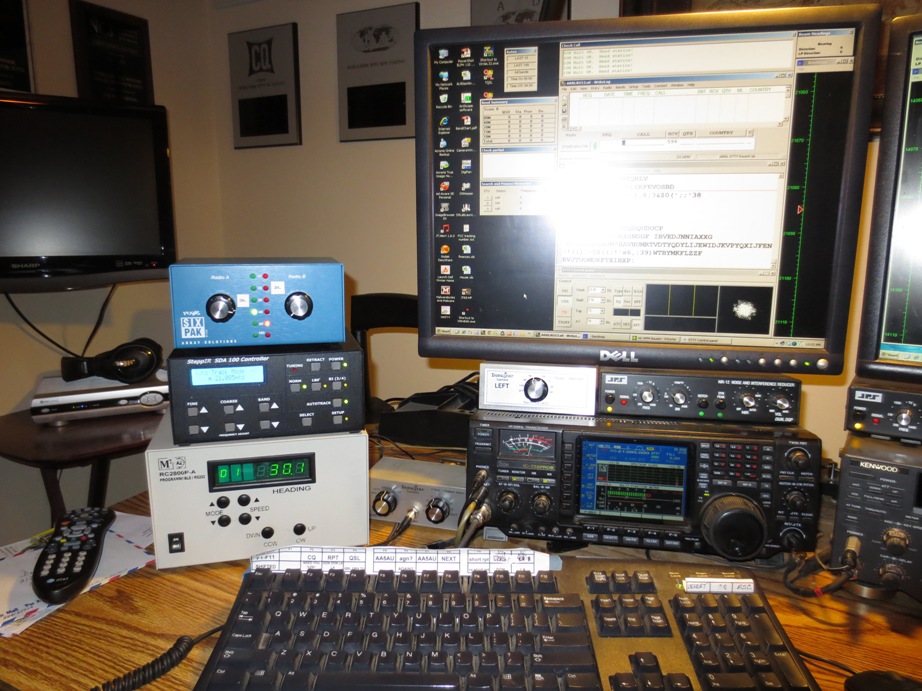 “Left” radio consisting of Icom IC-756 PRO III with SixPak, SteppIR controller, M2 rotor controller, headphone switch, Dunestar filter switch & NIR-12 filter
“Left” radio consisting of Icom IC-756 PRO III with SixPak, SteppIR controller, M2 rotor controller, headphone switch, Dunestar filter switch & NIR-12 filter
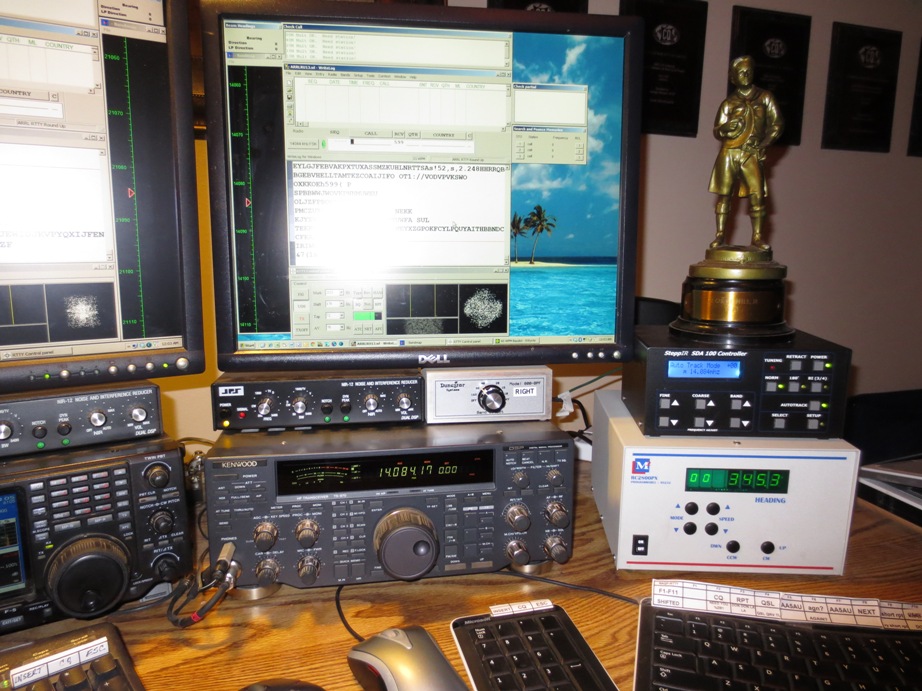 “Right” radio consisting of Kenwood TS-870, SteppIR controller, M2 rotor controller, Dunestar filter switch & NIR-12 filter (The statue was given to my father, George Hill, WB9FAD, who became SK in 2012, for his work as a Boy Scout master in 1961)
“Right” radio consisting of Kenwood TS-870, SteppIR controller, M2 rotor controller, Dunestar filter switch & NIR-12 filter (The statue was given to my father, George Hill, WB9FAD, who became SK in 2012, for his work as a Boy Scout master in 1961)
AA5AU 3830 report:
Call: AA5AU Operator(s): AA5AU Station: AA5AU Class: Single Op LP QTH: LA Operating Time (hrs): 24 Radios: SO2R Summary: Band QSOs ------------ 80: 232 40: 374 20: 774 15: 580 10: 60 ------------ Total: 2020 State/Prov = 58 Countries = 68 Total Score = 254,520 Club: Louisiana Contest Club
Radios:
Icom IC-756 PRO III running 100 watts
Kenwood TS-870 running 90-95 watts
Antennas:
3 element SteppIR @ 45'
2 element SteppIR @ 35'
80M inverted vee with apex at 40'
40M inverted vee with apex at 40'
Pixel receiving loop @ 36'
Other stuff:
Dell Dimension desktop PC running XP with WriteLog V11.08B
Dell Inspiron laptop running XP with WriteLog 11.08B
M2 RC2800 rotor controllers (2)
Dunestar 600 band filters (2)
Array Solutions SixPak 2-radio antenna switch
JPS NIR-12 Dual DSP audio filters (2)
Dunestar 842 2-radio headphone selector
Heil Pro Set Elite headphones
Icom PS-60 power supply
Astron 40 amp power supply

